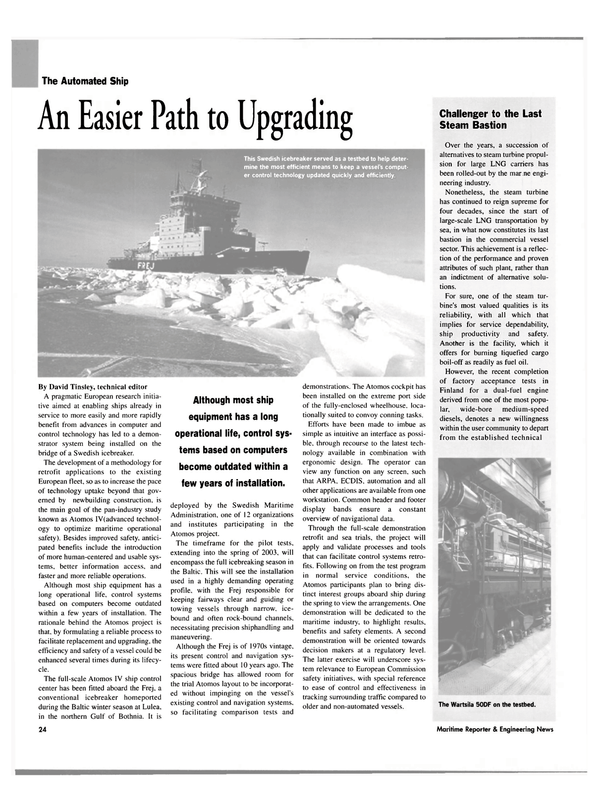
An Easier Path to Upgrading
A pragmatic European research initiative aimed at enabling ships already in service to more easily and more rapidly benefit from advances in computer and control technology has led to a demonstrator system being installed on the bridge of a Swedish icebreaker.
The development of a methodology for retrofit applications to the existing European fleet, so as to increase the pace of technology uptake beyond that governed by newbuilding construction, is the main goal of the pan-industry study known as Atomos IV(advanced technology to optimize maritime operational safety). Besides improved safety, anticipated benefits include the introduction of more human-centered and usable systems, better information access, and faster and more reliable operations.
Although most ship equipment has a long operational life, control systems based on computers become outdated within a few years of installation. The rationale behind the Atomos project is that, by formulating a reliable process to facilitate replacement and upgrading, the efficiency and safety of a vessel could be enhanced several times during its lifecycle.
The full-scale Atomos IV ship control center has been fitted aboard the Frej, a conventional icebreaker homeported during the Baltic winter season at Lulea, in the northern Gulf of Bothnia. It is deployed by the Swedish Maritime Administration, one of 12 organizations and institutes participating in the Atomos project.
The timeframe for the pilot tests, extending into the spring of 2003, will encompass the full icebreaking season in the Baltic. This will see the installation used in a highly demanding operating profile, with the Frej responsible for keeping fairways clear and guiding or towing vessels through narrow, icebound and often rock-bound channels, necessitating precision shiphandling and maneuvering.
Although the Frej is of 1970s vintage, its present control and navigation systems were fitted about 10 years ago. The spacious bridge has allowed room for the trial Atomos layout to be incorporated without impinging on the vessel's existing control and navigation systems, so facilitating comparison tests and demonstrations. The Atomos cockpit has been installed on the extreme port side of the fully-enclosed wheelhouse. locationally suited to convoy conning tasks.
Efforts have been made to imbue as simple as intuitive an interface as possible, through recourse to the latest technology available in combination with ergonomic design. The operator can view any function on any screen, such that ARPA, ECDIS, automation and all other applications are available from one workstation. Common header and footer display bands ensure a constant overview of navigational data.
Through the full-scale demonstration retrofit and sea trials, the project will apply and validate processes and tools that can facilitate control systems retrofits.
Following on from the test program in normal service conditions, the Atomos participants plan to bring distinct interest groups aboard ship during the spring to view the arrangements. One demonstration will be dedicated to the maritime industry, to highlight results, benefits and safety elements. A second demonstration will be oriented towards decision makers at a regulatory level.
The latter exercise will underscore system relevance to European Commission safety initiatives, with special reference to ease of control and effectiveness in tracking surrounding traffic compared to older and non-automated vessels.
Although most ship equipment has a long operational life, control systems based on computers become outdated within a few years of installation.
Read An Easier Path to Upgrading in Pdf, Flash or Html5 edition of March 2003 Maritime Reporter
Other stories from March 2003 issue
Content
- Title XI: Left Out in the Cold page: 8
- ULCC: Hellespont Alhambra Proves Efficient page: 10
- U.S. Sues NNS For Alleged Overcharges page: 14
- Associations Welcome Prestige Captain Release page: 15
- Titan to Develop and Build Navy X-Craft page: 15
- Open Letter to the U.S. Coast Guard Regarding Maritime Security page: 18
- An Easier Path to Upgrading page: 24
- Challenger to the Last Steam Bastion page: 24
- LCS and Deepwater Share Much page: 26
- IZAR Shows Its Mettle in the Gas Sector page: 28
- Japanese TSL a Reality page: 31
- Reagan Cuts an Imposing Path page: 32
- Ministry With A Mission page: 36
- Alstom Has Innovative Spill Clean Up Concept page: 38
- GMD Performs Evergreen Repair page: 43
- ASRY Comes Up Aces page: 43
- Dockyard Doubles Its Prosperity page: 44
- Microbiologically Influenced Corrosion (MIC) page: 48
- NACExpo 2003 Set for San Diego page: 49


